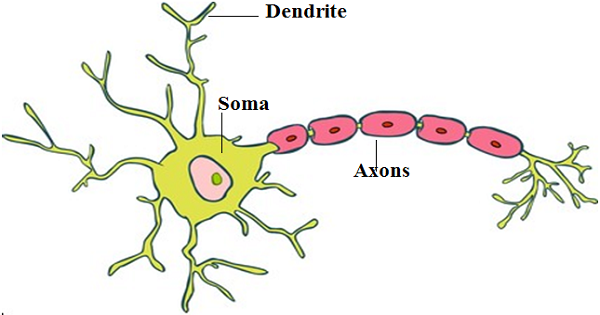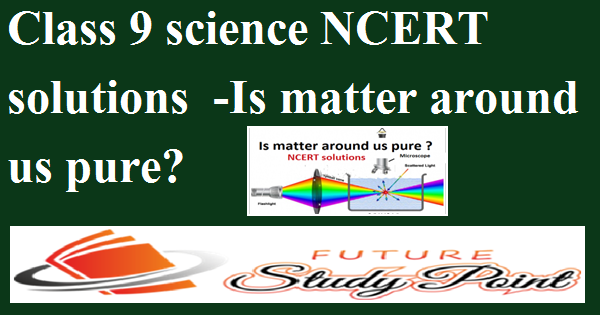NCERT solutions of class 9 science chapter 6-Tissues
NCERT solutions of class 9 science chapter 6-Tissues are available here for helping the students of class 9 in the creation of notes of questions and answers of class 9 science textbook. These NCERT solutions of class 9 science chapter 6-Tissues are explained beautifully by an expert of biology. NCERT solutions of class 9 science chapter 6-Tissues will clear all the concepts related to the chapter 6 which are necessary for every student of 9 class.
Click for online shopping
Future Study Point.Deal: Cloths, Laptops, Computers, Mobiles, Shoes etc
Download PDF of NCERT solutions of class 9 science chapter 6-Tissues
NCERT solutions of class 9 science chapter 6-Tissues
Page 69
Q1.What is a tissue?
Ans.A group of identical cells in structure destined to do a particular function is known as tissue.
Q2.What is the utility of tissues in multicellular organisms?
Ans.In multicellular organisms the tissues provide mechanical and structural strength and allow all parts of the body to do different types of tasks.
Page 73
Q1.Name types of simple tissues.
Ans. The type of simple tissues are following.
(I) Parenchyma
(ii) Collenchyma
(iii) Sclerenchyma
Q2.Where is apical meristem found?
Ans. Apical meristem is a non-permanent tissue which is found in the tip of shoot and tip of the root.
Q3.Which tissue makes up the husk of coconut?
Ans. The Sclerenchyma tissue ,which is a type of permanent tissue makes up the husk of the coconut. These tissues causes the plant to become stiff and hard. The cells of this tissue are dead and their cell walls are thickened because of the presence of the login.
Q4. What are the constituents of phloem?
Ans.The phloem constitutes of the following four elements, they are
(I) Sieve tube
(ii) Companion cells
(iii) Phloem parenchyma
(iv) Phloem fibres
Page 77
Q1. Name the tissue responsible for the movement of our body.
Ans. The tissue responsible for the movement of our body is muscular tissue.
Q2.What does a neuron look like?
Ans. The neuron looks like a tree, there are branched or spikes-like structures extended from the cell body known as dendrites which receive chemical messages from the axon of the adjoint neuron and convert them into electrical impulses, these signals further transmitted to soma which contains the nucleus. The signal is processed in the soma and send out it to axons as an output.
Q3.Give three features of cardiac muscles.
Ans.Three features of cardiac muscles are following.
(i) Cardiac muscles ars involuntary muscles.
(ii) Cardiac muscles are uninucleated.
(iii)Cardiac muscles are cylindrical in shape
Q4.What are the functions of areolar tissue?
Ans. Areolar tissues are the animal tissues that exist between the skin and muscular tissues, around blood vessels, nerves, and bone marrow. It supports the organs present in the abdominal cavity.
Exercise
Q1. Define the term “tissue”.
Ans. Group of cells that are similar in structure and perform the same function is called a tissue.
Q2. How many types of elements together make up the xylem tissue? Name them.
Ans. The Xylem is made up of vessels, tracheids, xylem fibers, and xylem parenchyma
Q3. How are simple tissues different from complex tissues in plants?
Ans. Simple tissues are made up of one type of cell which coordinates to perform a common function. Complex tissues are made up of more than one type of cell. All these coordinate to perform a common function.
Q4. Differentiate between parenchyma, collenchyma, and sclerenchyma on the basis of their cell wall.
Ans. Parenchyma: The cells have thin cell walls made up of cellulose.
Collenchyma: The cells have cell wall thickness at the comers due to pectin deposition.
Sclerenchyma: Their walls are thickened due to lignin deposition.
Q5. What are the functions of stomata?
Ans. The outermost layer of the cell called the epidermis and is very porous. These pores are called stomata. These stomata help in the transportation and exchange of gases
Q6. Diagrammatically, show the difference between the three types of muscle fibers.
Ans. There are three types of muscles fibers, they are
1. Cardiac Muscles: Cardiac muscles present in the heart, they are involuntary muscles and have a single nucleus, they have branched muscle fibres.
2.Smooth Muscle:Smooth muscles are found in lungs and ailimentary canal, they are involuntary muscles and have a single nucleus,they are of spindle shape.
3.Striated Muscle: They are connected with bones,they are involuntary muscles,they are lonng and have cylindrical muscle fibres,they posses many nuclei,these muscles are unbranched.
.
Q7.What is the specific function of the cardiac muscle?
Ans. The cardiac muscles branched and cylindrical . They have a single nucleus and are involuntary in nature, the rhythmic contraction and relaxation of the heart is due to the binding of myosins and calcium ion induction between one muscle fiber to another.
Q8.Differentiate between striated, unstriated, and cardiac muscles on the basis of their structure and site /location in the body.
Ans.The following are the differences between different type of muscles based on their structure and location in the body.
Striated Muscle: These muscles are long, cylindrical, and multinucleated. The striated muscles are found in the hands and legs part of our body.
Unstriated Muscle: These muscles are having the shape of a spindle and unnucleated. The unstriated muscles are found in the mouth, stomach, intestine, and inner lining of our eye.
Cardiac Muscle: The shape of cardiac muscles are cylindrical and uninucleated. The cardiac muscles are found in the heart.
Q9. Draw a level diagram of neuron.
Q10.Name the following.
(a) Tissue that forms the inner lining of the mouth.
(b) Tissue that connects muscle to bone in humans.
(c) Tissue that transports food in plants.
(d) Tissue that stores fat in our body.
(e) Connective tissue with the fluid matrix.
(f) Tissue present in the brain.
Ans.
(a) Tissue that forms the inner lining of the mouth is epithelial tissue.e squamous epithelial tissue
(b) Tissue that connects muscle to bone in humans is the tendon.
(c) Tissue that transports food in plants is phloem.
(d) Tissue that stores fat in our body adipose tissue.
(e) Connective tissue with the fluid matrix is blood.
(f) Tissue present in the brain is nervous tissue.
Q11.Identify the type of tissue in the following.
Skin. the bark of tree, bone, the lining of kidney tubule, vascular bundle
Ans.
Skin: Striated squamous epithelial tissue
The bark of tree: Protective tissue and cork
Bone: Connective tissue
The lining of the kidney tubule: Cuboidal epithelial tissue
Vascular bundle: Complex permanent tissue(conducting tissues. xylem and phloem)
Q12. Name the regions in which parenchyma tissue is present.
Ans. The parenchyma is found in the pith of stem and root and in leaves, when parenchyma contains chlorophyll then it is known as chlorenchyma. Parenchyma that found in aquatic plants forms larger air cavities known as collenchyma, it helps aquatic plants in floating on the surface of the water.
Q13.What is the role of the epidermis in plants?
Ans. The epidermis is the outer layer of the plants, it has several functions, it protects water loss, regulates the exchange of gases, secretes metabolic compounds, in roots, it absorbs water and minerals moreover it provides mechanical protection to the plant.
Q14.How does the cork act as a protective tissue?
Ans. Cork cells are dead cells and are largely dense, there is no intercellular space between them. Suberin a lipophilic macromolecule exist on the walls of cork cell protects water loss and protects from pathogens.
Q15. Complete the following chart.
Ans.
NCERT Solutions of Science and Maths for Class 9,10,11 and 12
NCERT Solutions for class 9 maths
NCERT Solutions for class 9 science
CBSE Class 9-Question paper of science 2020 with solutions
CBSE Class 9-Sample paper of science
CBSE Class 9-Unsolved question paper of science 2019
Study notes of Maths and Science NCERT and CBSE from class 9 to 12
NCERT Solutions for class 10 maths
CBSE Class 10-Question paper of maths 2021 with solutions
CBSE Class 10-Half yearly question paper of maths 2020 with solutions
CBSE Class 10 -Question paper of maths 2020 with solutions
CBSE Class 10-Question paper of maths 2019 with solutions
NCERT Solutions for Class 10 Science
NCERT Solutions for class 11 maths
| Chapter 1-Sets | Chapter 9-Sequences and Series |
| Chapter 2- Relations and functions | Chapter 10- Straight Lines |
| Chapter 3- Trigonometry | Chapter 11-Conic Sections |
| Chapter 4-Principle of mathematical induction | Chapter 12-Introduction to three Dimensional Geometry |
| Chapter 5-Complex numbers | Chapter 13- Limits and Derivatives |
| Chapter 6- Linear Inequalities | Chapter 14-Mathematical Reasoning |
| Chapter 7- Permutations and Combinations | Chapter 15- Statistics |
| Chapter 8- Binomial Theorem | Chapter 16- Probability |
CBSE Class 11-Question paper of maths 2015
CBSE Class 11 – Second unit test of maths 2021 with solutions
NCERT solutions for class 12 maths
| Chapter 1-Relations and Functions | Chapter 9-Differential Equations |
| Chapter 2-Inverse Trigonometric Functions | Chapter 10-Vector Algebra |
| Chapter 3-Matrices | Chapter 11 – Three Dimensional Geometry |
| Chapter 4-Determinants | Chapter 12-Linear Programming |
| Chapter 5- Continuity and Differentiability | Chapter 13-Probability |
| Chapter 6- Application of Derivation | CBSE Class 12- Question paper of maths 2021 with solutions |
| Chapter 7- Integrals | |
| Chapter 8-Application of Integrals |
Class 12 Solutions of Maths Latest Sample Paper Published by CBSE for 2021-22 Term 2
Class 12 Maths Important Questions-Application of Integrals
Solutions of Class 12 Maths Question Paper of Preboard -2 Exam Term-2 CBSE Board 2021-22
Solutions of class 12 maths question paper 2021 preboard exam CBSE Solution









